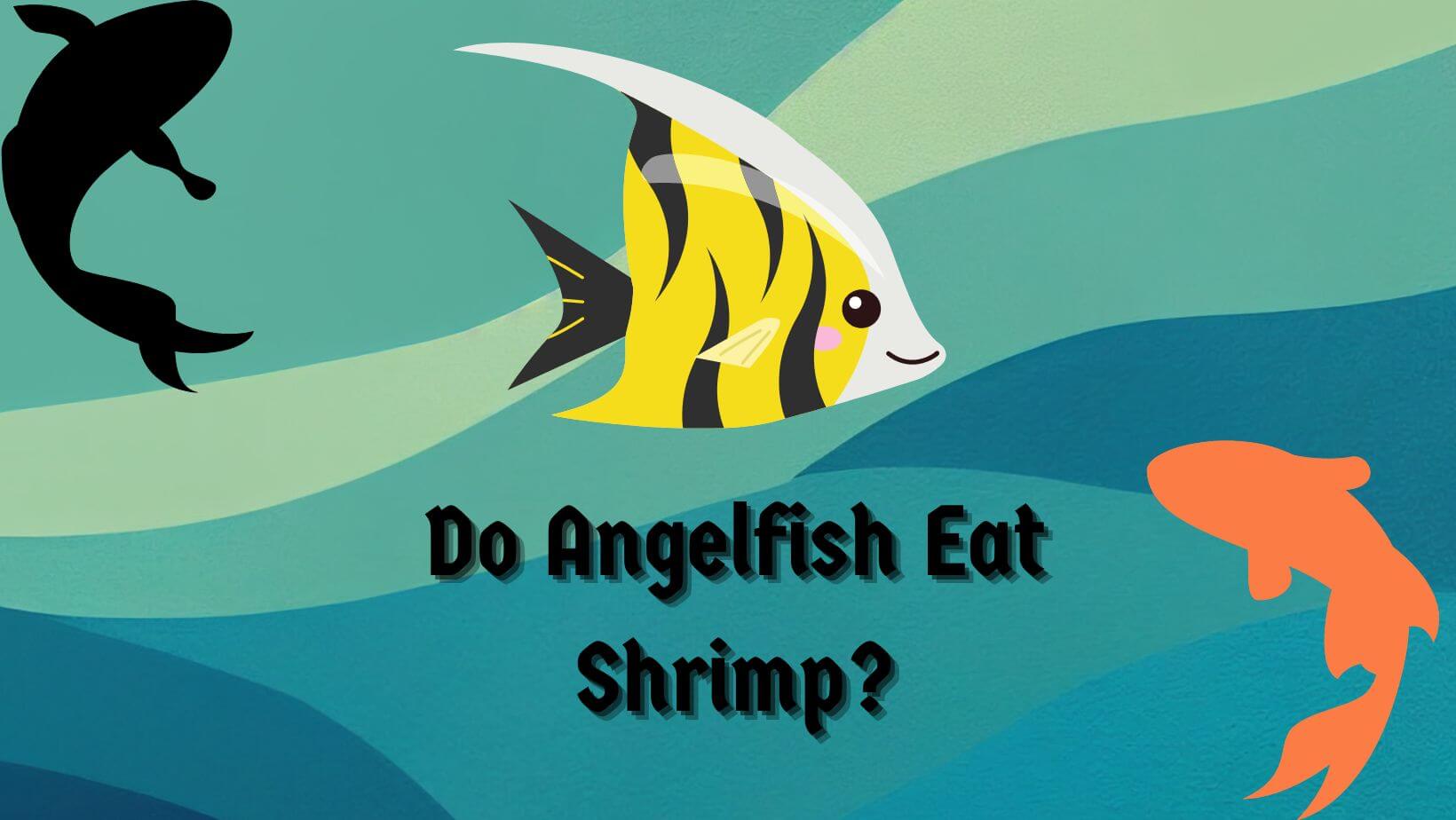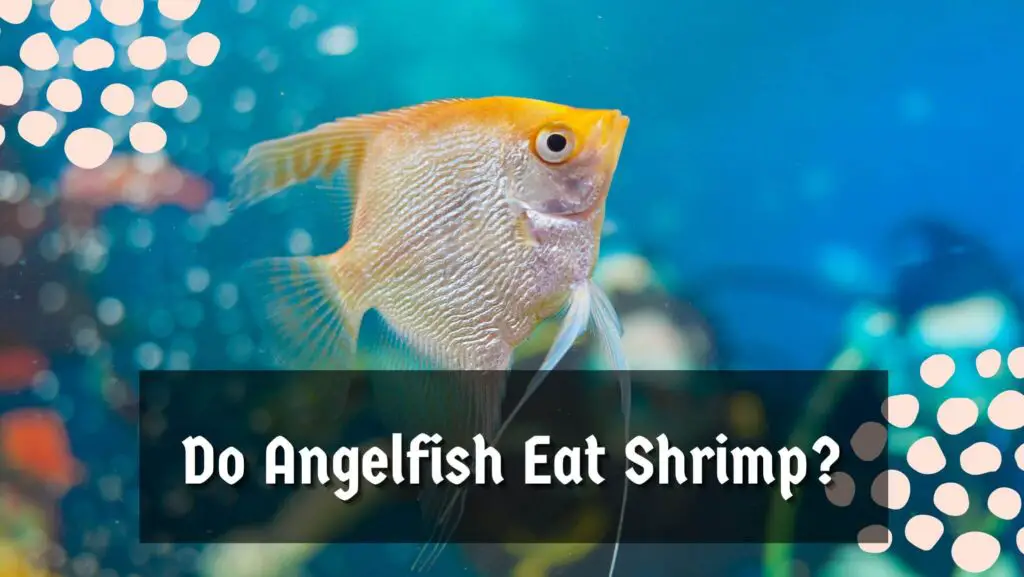
If you want to put shrimps in your angelfish aquarium, this is the article for you. In this article, I am not only going to answer ‘Do angelfish eat shrimp,’ but we will also be discussing the feeding habits of both species while exploring their relationship with shrimp.
As you know, Angelfish are fascinating creatures that belong to the family Cichlidae and are particularly popular for their extensive triangular shape & longitude fence.
Therefore, if you want to diversify the living pets in your aquarium to add an extra layer of elegance, there are a few things to know.
Since Angelfish are native to the Amazon River basin in South America, it is important to know whether they have a feeding habit of preying on shrimps or can inhabit the same habitat without interfering with their livelihood. Hence, without wasting time, let’s get a clear answer: can Angelfish eat shrimps?
Do Angelfish Eat Shrimp?

Yes, Angelfish are known to eat and prey on shrimp. Since they prefer an omnivorous diet and are known to eat both plant & animal matter, Angelfish will not mind enjoying some animal protein invertebrates like insects, worms, and even shrimps.
Keeping shrimps in the angelfish aquarium may result in ultimate predation and a quick decline in the shrimp population. Some shrimp may coexist together with Angelfish depending upon their species & size. It’s better to avoid adding shrimp or consider their size and consult with a professional Aquarist to gain more valuable insight into their coexistence in the same aquarium.
You should know that Angelfish do have a penchant for these crustaceans. And if you are thinking of adding fresh, live shrimps into their aquarium, the Angelfish may feel enticed to prey on them due to shrimp’s movement & nutritional value.
According To AZ Animals, angelfish can eat various types of aquatic creatures in their natural habitat, including shrimps, as a part of their diet. When we look at the Angelfish living in the wild, they are observed feeding on a diverse range of prey, adapting to their available food source in their environment.
Therefore, it’s not uncommon for Angelfish to exhibit hunting behavior and use different techniques to capture their prey, like shrimps. Like many other Ocean creatures, Angelfish have also been blessed with a keen sense of sight and use their acute vision to spot movement or detect potential food sources in the flowing or stable water.
I have personally observed my Angelfish’s voracious appetite for shrimp. My neighbor tried introducing live shrimps into the tank, and the Angelfish immediately became alert & started hunting.
You should know that Angelfish can show impressive hunting techniques while chasing down your shrimps with remarkable agility. Even though it’s a sight to behold, you should take precautions and avoid adding shrimp to their habitat/tank.
A few factors may also influence your pet’s Angelfish interaction with shrimp as potential prey. Most of these factors include tank condition, shrimp characteristics, and the availability of alternate food options in the tank. Let’s look at three factors influencing predatory angelfish habits or feeding behavior.
3 Factors Influencing Angelfish’s Feeding Behaviour

Tank Conditions
It would help if you kept the aquarium’s condition proper and clean because it also plays a significant role in the behavior of Angelfish and their feeding habit. You should pay attention to the water parameters like temperature, pH level, and hardness which must be maintained within suitable ranges.
You must know that Angelfish are known to thrive in slightly acidic water that comes with a pH level between 6.5 & 7. Also, you must provide proper filtration & regular water changes to create a healthy environment for your pets.
I have shared a recent article on how temperature is also affecting the metabolic rate & digestion of many Marine animals, including Angelfish. Therefore, ensure you keep the optimal temperature range of 72-82° Fahrenheit for your Angelfish to provide a stable & consistent temperature that ensures their healthiness and activeness. To know more, read: Angelfish Water Temperature
Also, make sure that the tank you provide is spacious & big, as it may also influence the feeding behavior of Angelfish.
It would help if you never kept Angelfish in a smaller tank. They may feel stressed or bored, resulting in territorial behavior and further impacting their feeding habits and patterns. Ensure you provide sufficient swimming space or create a well-planted environment that generally increases their natural foraging behavior.
Shrimp Characteristics
You should also pay attention to the characteristics of the shrimps as it may impact their vulnerability to Angelfish predation. If you are getting larger shrimp species like Amano shrimps or ghost shrimps, you will have a better chance of keeping them together peacefully due to their size & defensive behavior.
Yes, larger shrimp species can stand a better chance of coexisting peacefully and avoid predation. These largest shrimps can use their size advantages and speed to evade Angelfish predation. On the other hand, if you are thinking of adding the smallest species, like red cherry shrimps or crystal red cherry shrimps, don’t do it.
Smaller shrimp species are more prone to becoming angelfish snacks or breakfast as they tend to have a higher risk of being targeted and consumed by them due to their size & limited defense capabilities.
In my experience, larger shrimp species tend to have a higher survival rate when kept with Angelfish. Amano shrimp, known for their size and ability to defend themselves, can often peacefully coexist with Angelfish.
These shrimp species have a higher chance of surviving in the presence of Angelfish due to their larger size and mysterious behavior. Also, smaller shrimp species tend to carry vibrant colors and are particularly known for slower movements, making them more noticeable and attractive as prey to our little friend angelfish.
Availability Of Food Sources
Depending on the availability of food sources, the feeding & predation pattern of Angelfish may also get influenced. It is important to note that Angelfish, who were forced to live with limited food options, may also exhibit predation behavior on shrimps.
If you are not providing a proper amount of food from time to time to your fish, they may even try to bite or nip larger shrimps out of hunger. You must provide a small amount of food to your fish every few hours to keep them active, healthy, and friendly with other species living in the same tank.
What To Do?
As you now know, Angelfish tend to prey on shrimps naturally; a few strategies can promote peaceful coexistence between both species in the same aquarium. One of the most effective strategies I find to coexist with them is providing ample hiding places for the shrimps.
Consider incorporating live plants, rock, and driftwood into your aquarium to enhance its beauty and encourage natural foraging behavior. These hiding spots will also offer our shrimps a refuge whenever they sense danger, allowing them to evade the Angelfish predatory instinct.
There are many types of live plants that you can consider adding, like Java moss which is not only effective in providing shelter but also act as a natural food source for the shrimp. Java Moses is particularly famous for its dense foliage, which provides a sense of security to our shrimp and makes them less susceptible to predation.
In addition, consider adding or creating caves and crevices using rocks or driftwood, which will provide additional hiding spots while improving the visual interest of your aquarium. The other thing you can do to reduce the risk of shrimp predation is to employ the target feeling technique. It would help if you offered specific food to your Angelfish, like pellets or flakes.
In contrast, shrimps must be given their specialized food to minimize competition and the chances of Angelfish preying on stream. Target feeding always involves directing the food to a specific area of your tank to ensure each species receives its designated meal.
You should know that Angelfish should typically be fed with floating flakes or pellets easily consumed at the surface. On the other hand, consider offering sinking pellets and specialized shrimp food for your shrimps, allowing them to feed without being disturbed by the Angelfish.
Conclusion
Now you know that Angelfish are known to prey on streams as a part of their omnivorous type, so you should avoid keeping them together in the same tank. Even though you can take a few precautions to make them coexist together, it isn’t easy.
However, with larger shrimps, it is possible to accommodate both species in the same tank, but there should be enough space that allows free swimming and hiding spots to prevent predation or fighting.
In addition, it is also important to maintain the tank condition by maintaining its suitable water parameters and creating an environment that supports both specy’s wellbeing. Also, ensure you implement strategies like offering hiding places and employing target-feeling techniques to reduce the risk of shrimp predation.
I have given my best to give you all the information you need to know on the question: do Angelfish eat shrimps? If you find this article, then consider sharing it. Your share will help many people learn the answer to the question:
do Angelfish eat shrimps? if yes, what should they do about it? Do check my other helpful guide on Angelfish shared on this website. See you in the next post, till then, take care & goodbye.

